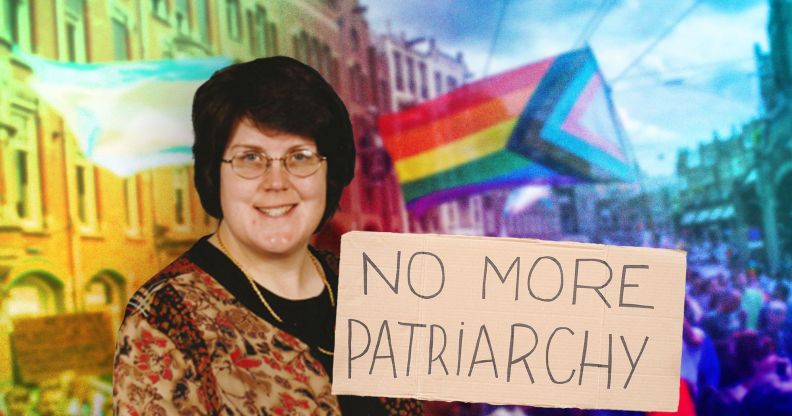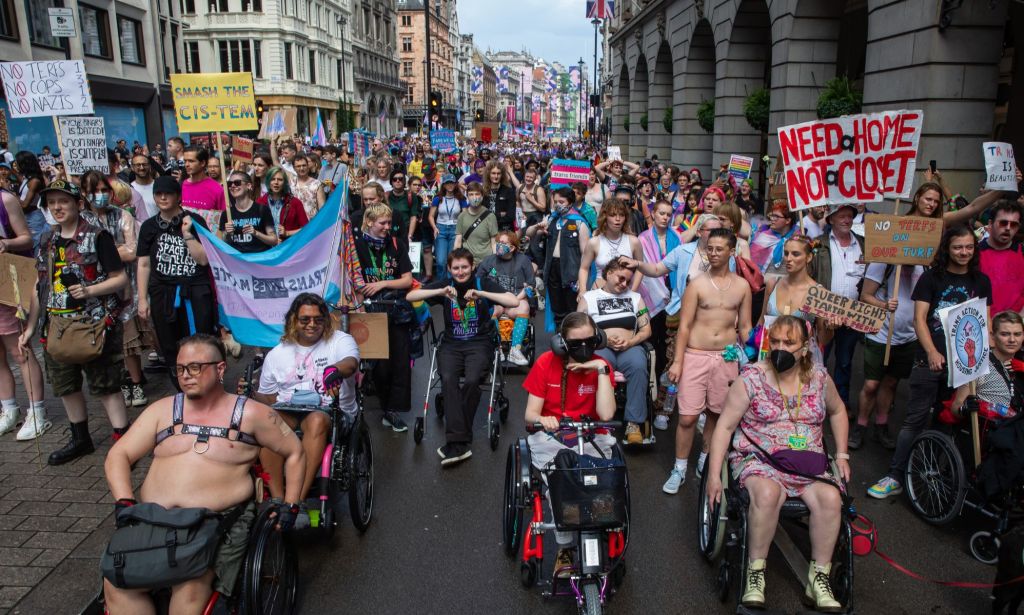Disabled lesbian explains why we all must come together to fight common enemy

Stephanie Suesan Smith previously said the same people fighting LGBTQ+ rights are also coming for disabled folks and anyone who isn’t a “rich, white, heterosexual” man. (Stephanie Suesan Smith/Getty)
As Disability Pride Month comes to a close, a woman at the intersection of the LGBTQ+ and disabled communities explains why both must “band together” to fight for a better future.
Stephanie Suesan Smith is a lesbian who lives with Parkinsonian syndrome, which can encompass a number of conditions with similar, movement-related effects.
Within the LGBTQ+ community, she’s encountered individuals who, although they may not realise it, are “acting in an ableist way”.
“For example, I belong to a gay garden club,” she tells PinkNews. “The last meeting we had was at a place downtown, we had a talk and then we were gonna go to a restaurant to eat.
“The restaurant was far enough that you had to drive. When I got there, there was no parking. I mean not just no [accessible] parking – no parking. You had to park in a public lot and hike a lot, and it was literally 100 degrees.”
Smith uses a walker because Parkinsonian syndrome makes it difficult for her to walk long distances. She used to “walk six miles every morning”, but is now “lucky if [she] can walk around the block”.
As a result, she wasn’t able to join the event. She emailed to group to inform them, and they responded “fairly appalled [in themselves] that they had failed to think about that”.
“So let’s say when you bring it to their attention, they are willing to accommodate you, but you have to bring it to their attention.”
Smith says in her experience, she’s also met disability activists who “don’t like” openly LGBTQ+ people within their community, “because they think that it makes them look odd, or bad”.
July is Disability Pride Month. Originating in the US in the 1990s, it promotes visibility and cultivates pride within the community while advocating for an inclusive world. It also creates opportunities to shift the conversation around disability and change notions around disabled people’s lived experiences.

If you haven’t heard of Disability Pride Month, you aren’t alone. Smith thinks it’s “pretty silent” compared to LGBTQ+ Pride Month – although she’s very clear that the two are not in competition.
Rather, she says the disabled and LGBTQ+ communities need to talk more about how they can fight prejudice together.
A lot of LGBTQ+ disabled people, like herself, are already fighting the growing, hate-motivated campaign against queer people seen in the US, where the Supreme Court is legalising discrimination, various states are facing legal action over gender-affirming healthcare bans, and presidential candidates are threatening to turn back the clock on equality.
Smith believes the current anti-LGBTQ+ backlash is an “extinction burst from the white nationalists”, who she says are a “hissy fit” to try to “keep their privilege”. She’s keen to fight them.
“A lot of us don’t have money,” Smith says. “I can’t walk that far. [But] I can write letters. I can gum people up in ethics communities and stuff like that.”
She says this coming together is especially important because the “same people” that are leading the attack on LGBTQ+ rights are also “coming for disabled people” – and “for anybody that’s not a rich, white, heterosexual man”.
“If we band together, we can get more done than if we fight separately,” she says.
“Instead of flailing, a few people flailing here and there, we could be this great, big crowd coming for them.
“A lot of people can make change. That’s why I think it’s important for both the LGBTQ+ community and the disabled community to realise there’s a lot of overlap.
“There’s a lot of overlap in the people that are in both groups. There’s so many things we could be working together to accomplish.”
Disabled LGBTQ+ people are often an overlooked intersection in society
The Centers for Disease Control and Prevention defines a disability as a “condition of the body or mind (impairment) that makes it more difficult for the person with the condition to do certain activities (activity limitation) and interact with the world around them (participation restrictions)”.
LGBTQ+ people are more likely than non-LGBTQ+ adults to self-report having at least one disability, according to a HRC Foundation analysis of the 2020 Behavioral Risk Factor Surveillance System .
One in three (36 per cent) queer adults self-reported having a disability compared to 24 per cent of adults not part of the LGBTQ+ community.

